Explore Hoa Binh - North Vietnam Travel, Asia
Nestled in the verdant mountains of northern Vietnam, Hoa Binh City is a destination where tradition meets tranquility. Just a short drive from the bustling capital of Hanoi, this city offers a refreshing escape into nature and culture. Hoa Binh, often called the "Gateway to the Northwest," is a treasure trove of ethnic diversity, natural wonders, and rich history for travelers looking to experience the authentic side of Vietnam. Here, you can immerse yourself in the daily lives of the Muong people, explore scenic landscapes, and discover the city’s deep historical roots.
Population: Approximately 135,000 in 2018.
Economy: Hoa Binh City's economy is primarily driven by agriculture, hydroelectric power, and tourism. The region is known for its fertile lands, traditional crafts, and the large Hoa Binh Hydropower Plant.
Landmarks: Famous for the Hoa Binh Hydroelectric Plant, Thung Nai, and Muong Cultural Space Museum.
Vietnam
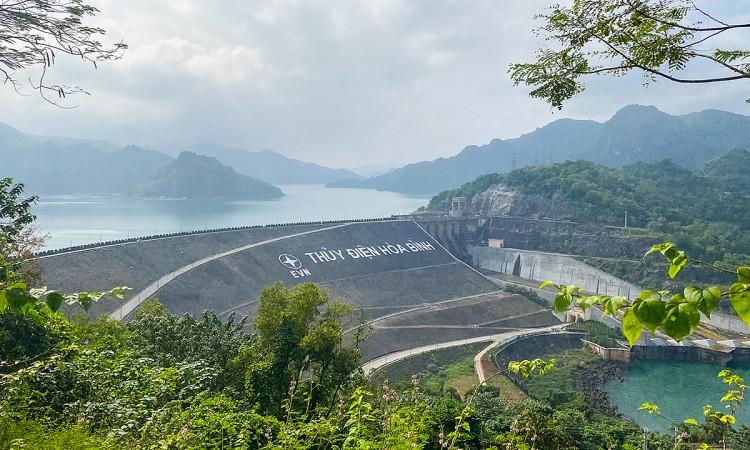
Overview of Hoa Binh
History & Cultural Influence
Hoa Binh city is not just a destination for natural beauty; it’s a place where history and culture come alive. The city has a long and storied past, deeply intertwined with the history of the Muong people, one of Vietnam’s oldest ethnic groups. The history of Hoa Binh is also marked by its strategic importance. During the French colonial period, Hoa Binh was a key battleground, and many of its historical sites still bear the marks of this era. Visitors can explore the remnants of French fortifications, visit ancient temples, and learn about the city’s role in Vietnam’s struggle for independence. Culturally, Hoa Binh is a vibrant tapestry of traditions. The Muong culture is particularly significant here, with its unique language, customs, and crafts.
Grab the chance to connect with Vietnamese locals in one of our Vietnam luxury tours here.
Interaction with the Locals
Hoa Binh city is home to a population of around 135,000 residents, a vibrant mix of ethnic groups, with the Muong people being the largest community. The city's citizens are known for their warmth, hospitality, and deep-rooted cultural traditions. This ethnic diversity enriches the local culture, making Hoa Binh a unique destination where ancient customs and modern life coexist harmoniously.
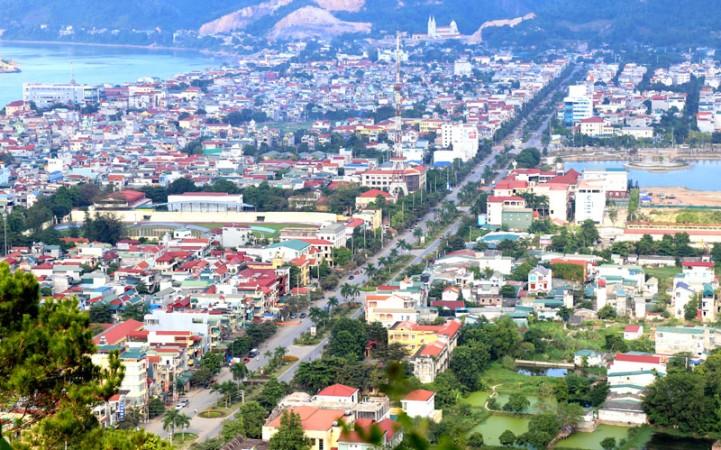
Hoa Binh city, Hoa Binh Province - © Hoa Binh People's Committee
Top Attractions in Hoa Binh
Hoa Binh city is brimming with attractions that showcase its natural beauty and cultural significance.
Hoa Binh Hydroelectric Plant
As one of Vietnam’s largest hydroelectric plants, the Hoa Binh Hydroelectric Plant is not just an engineering marvel but also a symbol of the city’s progress. Visitors can take tours to learn about the plant’s construction and its impact on the region. The panoramic views of the Da River and surrounding mountains from the plant are simply breathtaking.
Thung Nai
Often referred to as the “Halong Bay on Land,” Thung Nai is a picturesque area known for its serene beauty. The best way to explore Thung Nai is by boat, gliding through calm waters surrounded by lush greenery and towering limestone karsts. It’s a perfect spot for nature photography and peaceful relaxation.
Muong Cultural Space Museum
A visit to the Muong Cultural Space Museum is essential for anyone interested in the cultural heritage of Hoa Binh. The museum offers an immersive experience, with exhibits that include traditional Muong houses, tools, and clothing. It’s a place where you can truly appreciate the artistry and craftsmanship of the Muong people.
The museums around Vietnam are popular attractions for tourists. Check out our article about Hue, the old capital of Vietnam here.
Go Lao Waterfall
For those seeking adventure, Go Lao Waterfall is a must-visit. Tucked away in the mountains, this stunning waterfall is a haven for nature lovers. The trek to the waterfall is as rewarding as the destination itself, with lush landscapes and the sounds of nature accompanying you every step of the way. At the waterfall, you can take a refreshing dip in the cool waters or simply relax and enjoy the scenery.
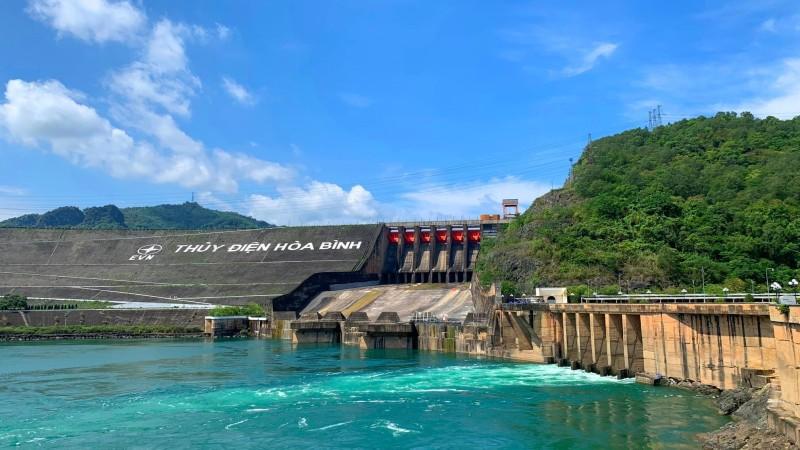
Hoa Binh Hydroelectric Plant - © EVN
Must-Try Dishes in Hoa Binh
Exploring Hoa Binh’s culinary tradition is a journey into the heart of Vietnamese and Muong culture. The local cuisine is characterized by its simplicity, freshness, and deep connection to the region's natural resources.
- Com Lam (Bamboo Rice): Com Lam is a traditional dish made from glutinous rice cooked inside bamboo tubes. The rice absorbs the subtle aroma of the bamboo, giving it a unique flavor. Com Lam is a popular dish among residents and tourists alike, and is frequently served with grilled meat or seafood. Com Lam is a unique and signature dish in many regions in northern Vietnam.
- Fermented Pork Roll (Nem Chua): Nem Chua is a tangy and slightly spicy fermented pork roll, wrapped in banana leaves. This dish is often enjoyed as a snack or appetizer and is a testament to the local tradition of preserving food.
- Banana Flower Salad: Banana Flower Salad is a refreshing and healthy dish, made from thinly sliced banana flowers, mixed with herbs, peanuts, and a light dressing. This salad, with its distinct aromas and texture, is a mainstay in many local dinners.
- Canh Loong (Muong Vegetable Soup): Canh Loong is a traditional soup made from a variety of wild forest vegetables, particularly popular among the Muong people. The soup is light, nutritious, and often served with steamed rice. This meal is a reflection of the Muong people's intimate ties to the natural world.
- Bitter Bamboo Shoots: Bitter bamboo shoots are a local specialty, often cooked in soups or stir-fries. The bamboo shoots are known for their slightly bitter taste, which is balanced by the addition of herbs and spices. This dish is a favorite during the bamboo shoot harvest season.
- Sticky Rice with Ant Eggs (Xoi Trung Kien): Xoi Trung Kien is a unique dish made with sticky rice and ant eggs, a delicacy in the region. The ant eggs are collected from the forest and mixed with sticky rice, creating a dish that’s rich in protein and flavor. It’s an adventurous choice for those looking to try something truly local.
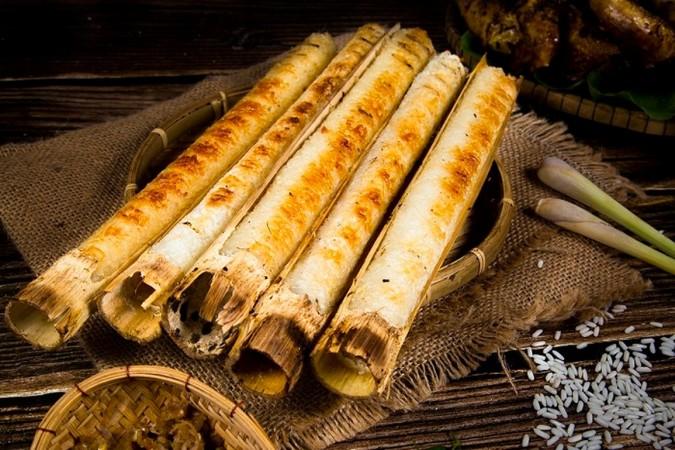
Com Lam (Bamboo Rice) - © Dan Tri News
Festivals & Local Celebrations
Hoa Binh is a hub of cultural activities, with festivals that celebrate its rich heritage and ethnic diversity. These festivals are a great way to experience the local culture firsthand.
Hoa Binh Ethnic Culture Festival
The Hoa Binh Ethnic Culture Festival is a vibrant celebration that brings together various ethnic groups from the region. The festival features traditional music, dance, and games, offering a colorful display of the city’s cultural diversity. It’s an event where visitors can immerse themselves in the local traditions and enjoy the festive atmosphere.
Muong Bi Festival
The Muong Bi Festival is one of the most significant cultural events in Hoa Binh, held annually to honor the Muong ancestors. The festival includes folk games, traditional dances, and rituals that have been passed down through generations. Attending the Muong Bi Festival is a unique opportunity to witness the deep-rooted traditions of the Muong people. The Muong people can be found in Dak Lak, a region lies in the deep area of central Vietnam.
Lunar New Year (Tet Holiday)
Tet Holiday, or the Lunar New Year, or Tet Nguyen Dan in Vietnamese tongue, is celebrated with great enthusiasm in Hoa Binh. The city comes alive with colorful decorations, traditional foods, and various cultural activities. It’s a time when families come together to celebrate and honor their ancestors, and visitors can join in the festivities to experience the warmth and hospitality of the local people.
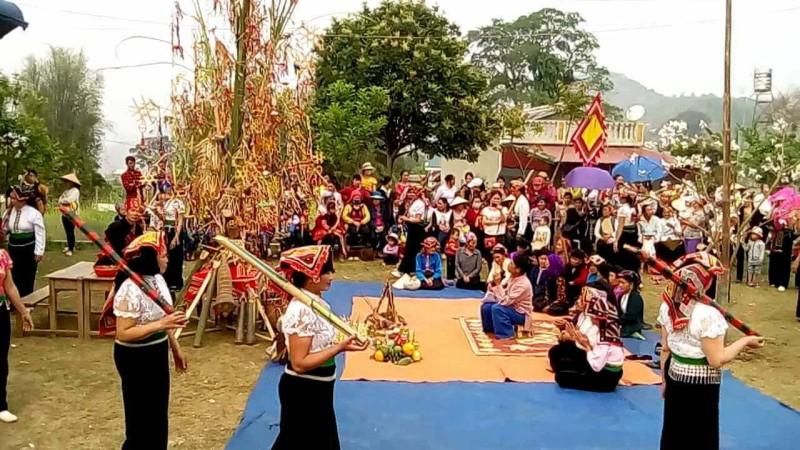
Hoa Binh Ethnic Culture Festival - © Vietnam Tourism
What to Do in Hoa Binh
Hoa Binh offers a wide range of activities that cater to different interests, making it an ideal destination for all types of travelers. These activities highlight the diverse experiences, ensuring that every visitor finds something enjoyable and memorable during their stay.
- Trekking in Hoa Binh: Explore the breathtaking landscapes of Hoa Binh by trekking and hiking through its lush forests and rolling hills. Several scenic trails lead you through picturesque villages and stunning viewpoints.
- Da River Boat Tours: Take a peaceful boat ride on the Da River to soak in the scenic surroundings. As you glide along the river, you’ll pass by charming riverside communities and enjoy panoramic views of Hoa Binh’s natural wonders.
- Participate in Cultural Workshops: Immerse yourself in the local culture by joining a cultural workshop. Learn traditional crafts like weaving and pottery from skilled artisans. These hands-on experiences allow you to gain a deeper understanding of the Muong people's traditions.
- Visit Local Markets: Stroll through Hoa Binh’s bustling local markets to experience the city’s vibrant atmosphere. Here, you can shop for fresh produce, handcrafted goods, and traditional textiles. The markets are also a great place to sample local street food and interact with friendly vendors.
Explore a variety of popular activities you can do across Vietnam here.
Shopping in Hoa Binh
Shopping in Hoa Binh City offers a unique opportunity to discover local crafts and take home authentic souvenirs that reflect the region's rich cultural heritage.
- Hoa Binh Market: Hoa Binh Market is the city’s lively commercial hub, where you can find a variety of goods ranging from fresh produce to handmade crafts. It’s an ideal spot to shop for traditional textiles, local delicacies, and unique souvenirs.
- Handicraft Shops: Hoa Binh is known for its exquisite Muong handicrafts, including weaving, embroidery, and woodwork. Several specialized shops in the city offer these handcrafted items, each made with care and traditional techniques.
- Specialty Product Stores: Explore stores that sell local specialty products like fermented bamboo shoots, dried mushrooms, and herbal teas. These items are not only delicious but also represent the region’s natural abundance and traditional preservation methods.
- Street Vendors: Don’t miss out on the small street vendors scattered around the city, where you can find everything from snacks to small trinkets. These vendors often sell unique, handmade items at affordable prices, providing a more personal shopping experience.
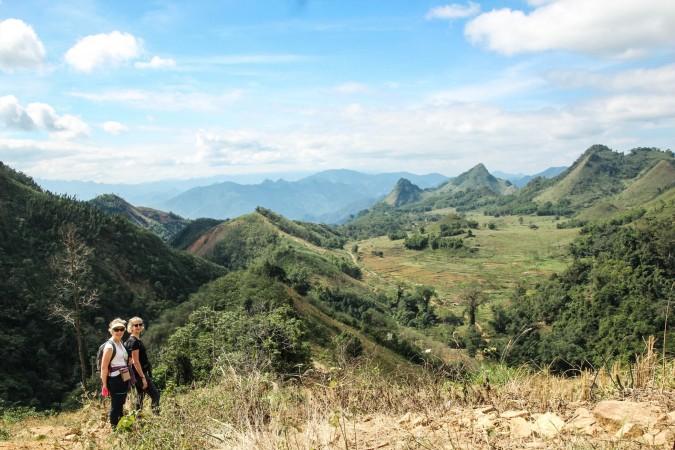
Trekking in Hoa Binh - © Lao Dong News
Weather in Hoa Binh: Best Time to Visit
Understanding the weather conditions in Hoa Binh can enhance your travel experience, helping you plan your activities and pack appropriately. The city enjoys a subtropical climate, with distinct seasons.
Spring in Hoa Binh
Hoa Binh's springtime is marked by pleasant weather and blossoming flowers. Daytime temperatures range from 20°C to 30°C (68°F to 86°F), making it an ideal time for outdoor activities like trekking and exploring local attractions. The weather is generally pleasant, with occasional light rain showers.
Summer in Hoa Binh
Summer in Hoa Binh can be hot and humid, with temperatures often exceeding 30°C (86°F). This season also brings frequent rain showers and thunderstorms. Despite the heat, summer is a great time to enjoy boating on the Da River and other water-based activities. Be prepared for sudden rain and consider light, breathable clothing.
Autumn in Hoa Binh
Autumn is one of the best times to visit Hoa Binh, with cooler temperatures ranging from 20°C to 28°C (68°F to 82°F) and less humidity. The weather is comfortable for exploring the city and surrounding areas. It’s also a season of vibrant colors, as the landscape transforms with fall foliage.
Winter in Hoa Binh
Winter in Hoa Binh is cooler, with temperatures dropping to around 15°C to 20°C (59°F to 68°F). Even if it doesn't get extremely chilly, it's a good idea to pack layers and a lightweight jacket. Winter is a more sedate season to visit, with clear sky and a serene ambience.
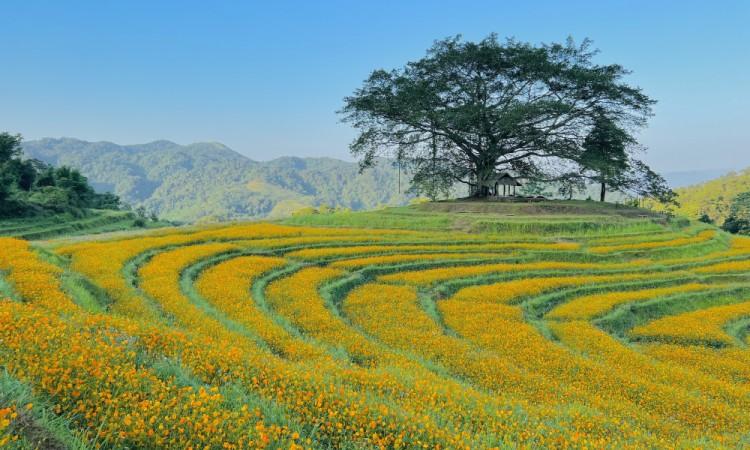
Spring in Hoa Binh - © VnExpress
Essential Travel Information
Getting Around Hoa Binh
Hoa Binh City is rather simple to navigate, having a variety of transportation choices to accommodate a range of tastes.
- Taxis and Ride-Sharing: Taxis are a convenient way to travel around the city. Ride-sharing apps are also popular and offer a comfortable and reliable alternative. Make sure to use reputable services and confirm the fare before starting your journey.
- Motorbike Rentals: For those who prefer a more adventurous way to explore, renting a motorbike is a popular option. It gives you the freedom to navigate the city and surrounding areas at your own pace. Make sure your driver's license is up to date, and for safety, wear a helmet.
- Public Buses: Public buses are an affordable and efficient way to travel within Hoa Binh City and to nearby destinations. Check local schedules and routes to plan your trips accordingly.
- Cycling: Cycling is another great option for exploring the city, especially if you enjoy a more leisurely pace. Many areas in Hoa Binh are bike-friendly, and renting a bicycle can provide a pleasant way to see the sights.
ATM & Banking Services
Hoa Binh City offers a variety of banking services and ATMs conveniently located throughout the area, including at banks, shopping centers, and tourist spots. Most ATMs accept international credit and debit cards, making cash withdrawals easy for visitors. Currency exchange services are available at banks and some hotels, with smaller transactions recommended upon arrival. While credit cards are widely accepted in many hotels, restaurants, and shops, it's advisable to carry some cash for smaller purchases.
Where to Stay in Hoa Binh
Hoa Binh City offers a range of accommodation options to suit different budgets and preferences. With various lodging options, you can find a place that fits your needs and enhances your visit to Hoa Binh City.
- Hotels: There are several hotels in Hoa Binh City, ranging from budget-friendly options to more luxurious stays. These hotels offer comfortable rooms and modern amenities, providing a convenient base for exploring the city.
- Guesthouses and Homestays: For a more intimate experience, consider staying at a guesthouse or homestay. These options often provide a closer connection to local life and culture, with hosts who can offer valuable insights and recommendations.
- Resorts: If you’re looking for a more upscale experience, there are resorts in the surrounding areas of Hoa Binh that offer scenic views, upscale facilities, and recreational activities. These resorts are ideal for a relaxing getaway.
- Budget Accommodations: For budget travelers, there are several affordable lodging options, including hostels and budget hotels. These provide basic amenities and are a good choice for those looking to save on accommodation costs.
Articles for you

Explore Yala National Park - Sri Lanka Travel, Asia
Tucked away in Sri Lanka’s southeastern corner, Yala National Park is where wild nature meets deep tradition. Known worldwide for its leopard population, the park is also home to elephants, sloth bears, crocodiles, and hundreds of bird species. Beyond wildlife, Yala opens doors to a cultural landscape dotted with ancient temples, Buddhist ruins, and coastal villages. For travelers seeking more than just a safari, Yala offers a chance to explore eco-tourism, local communities, and sacred heritage sites.
Population: The Yala National Park area doesn’t have a human population.
Economy: The economy around Yala National Park thrives on a blend of eco-tourism, agriculture, and local services. Safari tours, eco-lodges, and cultural experiences drive steady income for nearby towns like Tissamaharama and Kataragama, supporting thousands of families.
Landmarks: Famous for Block I of Yala and wildlife encounters, including elephants, sloth bears, crocodiles, and exotic bird species.

Explore Galle - Sri Lanka Travel, Asia
Nestled on Sri Lanka’s southern coastline, Galle is a vibrant city where history meets the sea. Its cobbled streets, colonial architecture, and serene beaches make it a must-visit destination for travelers seeking a blend of culture, adventure, and relaxation. A UNESCO World Heritage site, Galle captivates visitors with its Dutch Fort, bustling markets, and friendly locals. Whether you’re exploring the ramparts at sunset or savoring fresh seafood by the shore, Galle promises an unforgettable journey into Sri Lanka’s heritage.
Population: Approximately 113,000 in 2023.
Economy: Galle’s economy thrives on tourism, trade, and fisheries. The city’s historic fort, colonial architecture, and coastal charm draw thousands of international visitors each year, making tourism its main economic driver. Fishing remains vital for local livelihoods, supplying fresh seafood across the region.
Landmarks: Famous for the Galle Fort, Dutch Reformed Church & Maritime Museum, and Unawatuna Beach.

Explore Bentota - Sri Lanka Travel, Asia
Nestled along Sri Lanka’s southwestern coast, Bentota is a tropical paradise that blends golden beaches, vibrant culture, and thrilling adventures. Famous for its calm waters, luxury resorts, and scenic river estuary, Bentota has become a top destination for travelers seeking both relaxation and authentic experiences. From serene beach walks at sunrise to adrenaline-pumping water sports, this coastal town offers a perfect balance of leisure and exploration. With its proximity to Colombo and Galle, Bentota is easy to reach, making it an ideal stop for both short escapes and extended holidays.
Population: Approximately 37,000 in 2023.
Economy: Bentota’s economy thrives mainly on tourism, which drives local businesses such as hotels, restaurants, and wellness retreats. The town also benefits from fishing, coconut cultivation, and handicrafts like wood carving and batik textiles. Many residents rely on the growing demand for water sports and Ayurvedic treatments, making tourism the backbone of both income and employment in the area.
Landmarks: Famous for Bentota Beach, Bentota River Safari, and Kande Vihara Temple.

Explore Mirissa - Sri Lanka Travel, Asia
Mirissa is a charming coastal town on Sri Lanka’s southern shoreline. Known for its golden beaches, turquoise waters, and vibrant marine life, it has become a must-visit stop for travelers exploring the island. Many come for whale watching, surfing, and sunset views at Coconut Tree Hill, but Mirissa offers much more than postcard beauty. The fishing boats you see anchored by the bay carry generations of stories. Local traditions, delicious cuisine, and a laid-back rhythm of life shape every visitor’s experience.
Population: Approximately 4,700 in 2023.
Economy: Mirissa’s economy is largely shaped by its coastal location. Fishing has long been the backbone of local livelihoods, with generations relying on the Indian Ocean for income. In recent decades, tourism has become the main driver of growth, thanks to whale watching, surfing, and beachside hospitality.
Landmarks: Famous for Mirissa Beach, Coconut Tree Hill, and Parrot Rock Bridge.

Explore Nuwara Eliya - Sri Lanka Travel, Asia
Tucked away in the Central Highlands of Sri Lanka, Nuwara Eliya is often called “Little England”. With its rolling tea plantations, cool misty mornings, and colonial charm, this mountain town feels like a step into another world. Travelers come here to breathe fresh air, walk through flower gardens, sip the finest Ceylon Tea, and enjoy a pace of life far from the island’s busy cities. Whether you’re drawn by scenic landscapes, heritage architecture, or the warmth of its people, Nuwara Eliya is a destination that blends nature, culture, and history in perfect harmony.
Population: Approximately 781,000 in 2023.
Economy: Nuwara Eliya’s economy thrives mainly on tea production, as it sits in the heart of Sri Lanka’s central highlands, famous worldwide for Ceylon Tea. The city also benefits from a growing tourism industry, attracting visitors with its colonial charm, cool climate, and scenic landscapes.
Landmarks: Famous for Gregory Lake, Hakgala Botanical Garden, and Victoria Park.

Explore Sukau - Malaysia Travel, Asia
Nestled on the banks of the Kinabatangan River in Sabah, Malaysian Borneo, Sukau is a destination where wildlife, culture, and conservation come together. Known as one of Asia’s top spots for river safaris and eco-tourism, this quiet village offers a front-row seat to encounters with Bornean orangutans, pygmy elephants, proboscis monkeys, and exotic birdlife.
Population: Approximately 1,400 in 2019.
Economy: Sukau’s economy is shaped by its riverine location and natural resources. Traditionally, the Orang Sungai community relied on fishing, small-scale farming, and forest gathering for their livelihood. Today, the village has shifted toward eco-tourism, with river cruises, jungle trekking, and homestays providing income.
Landmarks: Famous for the Kinabatangan River cruises, Gomantong Caves, and Ox-bow lakes and wetlands.
